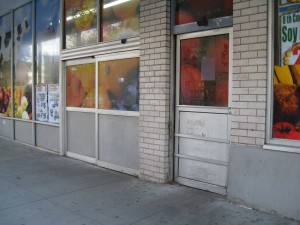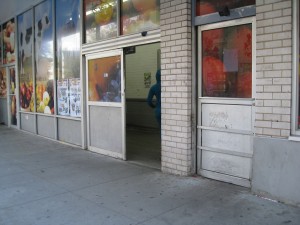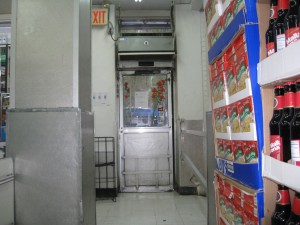An observation of an interactive technology
These videos demonstrate motion sensor doorways (I’m sure we’ve all been through many of them in supermarkets).
This weekend, at the supermarket, I observed people “using” the automatic doorways at Key Food. The notion of doors and doorways, which are ubiquitous devices in our daily lives, are often something we overlook, and they aren’t standardized, nor have their designs been perfected: how does someone know to push or pull on a door to open it? What side of the door, the left or right side, will make something happen, and what side is hinged in place (what direction will it swing or move in? How will the door open and close (slide, revolve…). What type of action does it require in order to respond? Since there aren’t really standardized doors, how do the designers get across the message? (with writing – Push, Pull; with a metal rectangle implying that the user should push against it; with a handle that the user can understand what to do to it?). And there are more things to consider, like how to prevent energy loss when the room is temperature-controlled (preventing cool air from an air conditioned room in the summer from escaping, or alternatively, preventing cool air from rushing into a heated room in the winter – revolving doors are good for this). Many supermarkets have automatic doors, for convenience sake, I imagine. People entering and leaving the market therefore interact with the door, but in a passive way. They don’t have to do anything extra than simply coming and going.
- outside, approach the door, and it will open to allow you to enter
- it opens as you approach
- it will remain open for a few seconds
- as you approach, it will open

There are design techniques that went into the sensor that opens the door, that take into account human behavior. I imagine it is a motion sensor on the outside of the door that spans horizontally, and if it detects an object in its path (it responds to inanimate objects as well), the door opens. Because of supermarket traffic, there is a designated “in” and “out” door. In this case, you entered to a door that was on the left of the door you ended up leaving from. The door also needs to remain open long enough for someone to walk through. As long as someone is outside of or in the doorway, it remains open. The door cannot shut on a slow walker, or that might be hazardous. In that sense, it is designed well. And, because there is an in door and an out door, the door is not generally opening unless someone intends to pass through it.
Because people don’t have to interact with the doorway in a way to make it respond, they only have to go about their actions (it’s lacking a handle or control), it works quite efficiently. However, sometimes if someone walks past the doorway, or lingers outside, it continuously opens, which can be jarring and annoying. I think that in order to prevent this from occurring excessively, the door, at least the one leading from inside out, is a little bit isolated (it is not out in the open, so that people pass by it, unnecessarily opening it, but it is at the end of a small corridor, so people have to intend to pass through it if they approach it, and set off the sensor.



